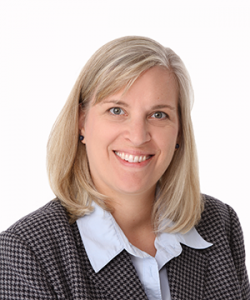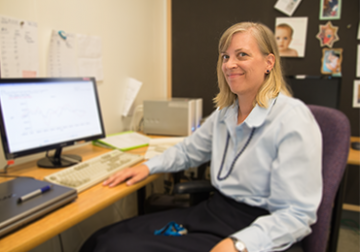
Susan Small
Many research labs at UBC are filled with Bunsen burners and beakers, but not Susan Small’s.
In her lab, you’ll find everything from baskets overflowing with children’s picture books to brightly-coloured bead counters. And don’t forget the rubber ducky. But these aren’t just toys — these are tools, critical to the success of her research as a pediatric audiologist.
Dr. Small, an Associate Professor in the School of Audiology and Speech Sciences and Hamber Professor of Clinical Audiology, is also the Director of UBC’s Pediatric Audiology Lab. It’s here that she uses different physiological and behavioural measures to study the hearing threshold in infants. Her research also focuses on the effect that auditory experiences have on early speech perception abilities of infants with normal hearing versus those who have been identified with hearing loss.
As part of National Audiology Month, we sat down with Dr. Small to learn more about her work and find out how parents can recognize the early signs of hearing loss and take steps to prevent avoidable hearing problems in infants and children.
If an infant or child has hearing loss, what are some of the major concerns when it comes to overall development and wellbeing?
Hearing loss can have a huge impact on an infant’s speech, language and psychosocial development. If an infant cannot hear properly — say, for example, they are suffering from an ear infection — then their auditory input is not normal, it’s muffled. Oftentimes, infants with frequent middle-ear infections can have trouble developing language skills and learning to talk because, compared to a baby with normal hearing, they have simply not had the same number of hours to process and learn what sounds mean.
For children, hearing loss can lead to concentration issues — in and out of the classroom. This is true even if a child has a milder hearing loss or, perhaps normal hearing in one ear, and no hearing in the other ear. Children with these conditions often develop very well, but some can face difficulty concentrating because, for them, it takes a lot more effort. If you have only one ear that is functioning normally, you can’t segregate sounds like you can with two. It’s much like having two eyes for depth perception.
How often should infants and children have their hearing tested?
Since 2006, newborn hearing screening has been universal in British Columbia — this came into place around the time I was completing my PhD. In fact, I had the opportunity to serve as a consultant and help select the screening and diagnostic equipment.
Here in B.C., we’re fortunate because there are still some provinces in Canada that have not implemented hearing screening for newborns.
Why is it important? Well, with infants, you don’t want to wait. Newborn screening allows you to identify hearing loss at birth, diagnose the presence of a hearing loss, and, if appropriate, have the baby fitted for hearing aids by as early as three months of age. Without newborn screening, a child with a moderate loss, or in some situations, a profound hearing loss, might be missed, so their speech and language development will be delayed significantly.
The next point in time that a child’s hearing is screened is typically before entering kindergarten.
After early childhood, there are not many school districts that continue to offer structured screening tests. If you suspect your child has a hearing loss, or suffers from chronic ear infections, you should take them to have their hearing tested.
What are some of the challenges of detecting hearing loss in infants, versus adults?

Dr. Susan Small at work in the Pediatric Audiology Lab at UBC’s School of Audiology and Speech Sciences
I worked with adults for many years and detecting hearing loss is relatively straightforward. You explain the diagnostic tests then proceed. Adults can also tell you what they can and cannot hear comfortably, and can explain the communication difficulties that they experience in their day-to-day lives.
It’s much harder to obtain information from a baby. We can’t just sit a baby down and say ‘put your hand up at the sound of the beep.’ Instead, we have to use appropriate diagnostic techniques — what we refer to as objective measures of hearing. The auditory brainstem response (ABR) is one example and requires placing sensors on a baby’s head to measure brain waves and determine whether or not the sound has been detected. But this form of testing relies on the baby to be asleep. So the first challenge is getting them to sleep and the second: keeping them asleep — they’re a tough crowd because once they wake up, you’re done.
When it comes to researching hearing development and loss in infants, you come against the same challenges — being a pediatric audiologist takes patience. When I was completing my PhD, I use to joke that my whole dissertation was in the hands of sleeping babies. Essentially, babies’ sleep patterns would determine whether or not I would graduate — that’s a lot of pressure for a baby! I also do studies when babies are awake — the challenge there is to keep the baby alert but not moving too much — not so easy!
For parents, what are some warning signs that their infant or child may be suffering from hearing loss?
For one, if your infant or young child is not turning to sound or not startling to loud sounds — like the slamming of a door — then it could be an indication that they have hearing loss.
Another indication that your child may be suffering from hearing loss is if, when they get beyond baby-hood, they don’t speak. There are many reasons for delayed speech — but one of them is that they’re not hearing normally.
Children who have difficulty hearing may also talk really loud. You’ll often notice a temporary increase in the level of a child’s voice if they have an ear infection because they can’t monitor their voices well and compensate for the hearing loss by talking louder.
Listening effort — or the amount of energy your child is putting into hearing — can also provide clues as to whether they are suffering from hearing loss. Look out for signs of listening effort: are they asking you to repeat words, or straining to hear what their playmates are saying? If so, it is a good idea to have their hearing tested.
What steps can parents take to help diagnose hearing loss in their infants and children, or avoid preventable hearing loss?
Some hearing conditions in infants and children are unavoidable — they are a result of genetic or pre-existing neural conditions, or infections, to name a few. But, when it comes to ‘things to watch out for,’ here are a few tips:
Avoid loud noises and remember less is better. Noise-induced hearing loss is always an issue, for everybody — whether you use a chain saw in your backyard or listen to really loud music. Damage will occur when sound exposure is too loud, for too long, too often. When it comes to children, avoid exposing them to loud noise unnecessarily — listening to music through head phones or ear buds, for example. Instead, let your children listen to music on speakers — that way, you can monitor the loudness. And remember that habits are hard to break so getting children to learn good ‘hearing’ habits early is important. A program by the Hearing Foundation of Canada, known as the Sound Sense Program, is helping to do just that.
Be careful with contact sports and head injuries. We already know to be careful about concussions — hearing loss can also result if a skull fracture occurs so children should take protective measures on the playing field and wear their bicycle helmets.
If your child has chronic ear infections, be sure to see a specialist. Ear infections can cause scar tissue and, in some cases, permanent sensory-type hearing problem.
If your child is not developing at the usual rate, get a second opinion because those early years are very important for normal speech-language and social development. You may consider using a baby communication checklist to make sure they’re reaching key speech and language milestones.
To find out more about the work of Dr. Small’s work, visit the School of Audiology and Speech Sciences’ Pediatric Audiology Lab webpage.
Looking to advance research in this area? The Pediatric Audiology Lab is always looking for willing parents and their babies to take part in research. You may contact Dr. Small at any time if you are interested in having your baby participate in her research studies.